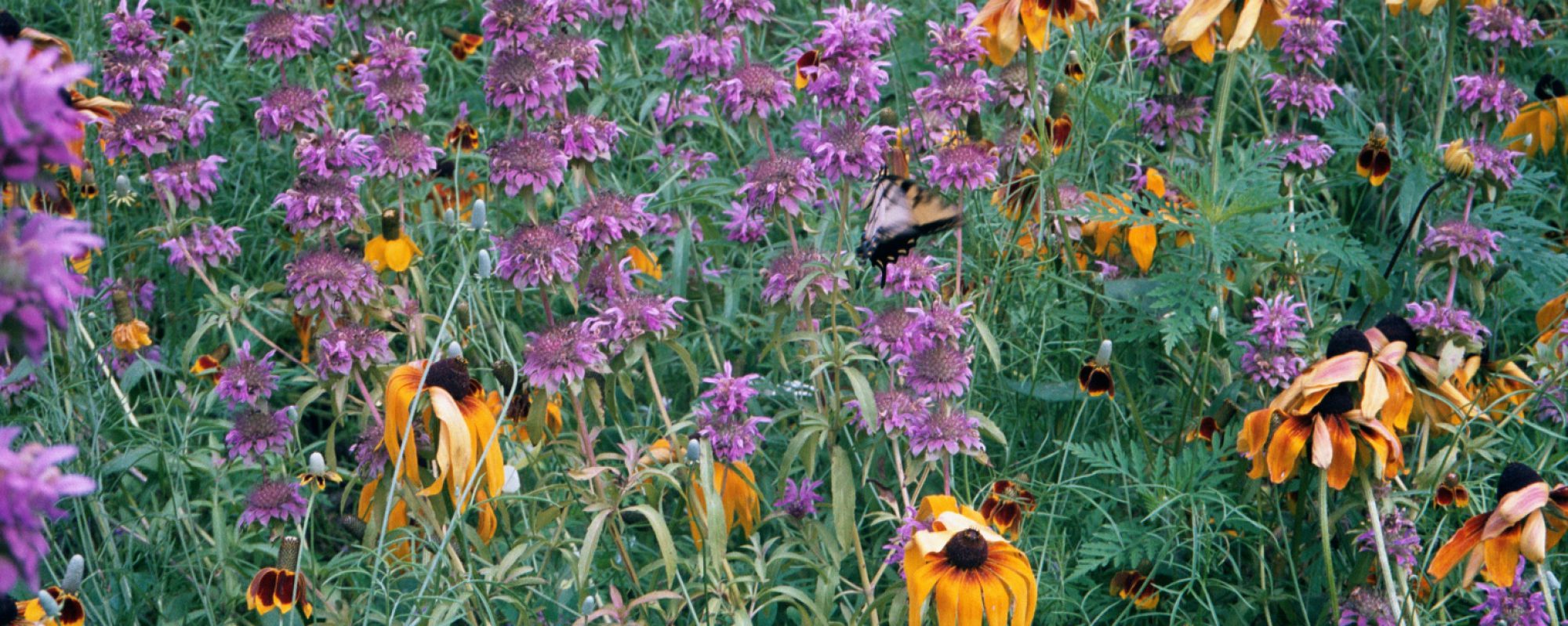Rain gardens are shallow, landscaped depressions that contain perennial native plants that don’t mind “getting their feet wet.” They’re designed to catch and soak in stormwater before it enters storm drainage systems and local waterways, which prevents and controls flooding in our communities. Rain gardens function not only as stormwater control, they also provide habitat for birds and butterflies and can be lovely and useful landscaping features to help manage those wet spots in your yard. Rain gardens can be easily installed by homeowners in both sunny and shady areas, and can allow 30% more water to soak into the ground compared to a conventional lawn.
Directing your water to a rain garden is a natural, effective solution to water pollution. It protects our rivers, streams, and lakes from pollution and gives you an attractive garden!
To capture any flow or access water on your property, you may consider installing rain gardens in areas currently maintained as turf grass or in areas where water pools. Installing rain gardens in these areas will reduce the amount of stormwater flowing towards your residence and towards frequently flooded areas of your property. Rain gardens include 3 – 4 inches of amended sand/compost soil media under 2 – 3 inches of mulch in the landscaped area. This soil media, in addition to the installation of native, wet-tolerant plant species, will promote improved stormwater infiltration into the ground. If you choose to install a rain garden, position the garden a minimum of 10 feet away from the foundation of the home.
Common Rain Garden Questions
Does a rain garden form a pond?
No. Rain gardens are designed and constructed so the collected water soaks into the ground, keeping the rain garden dry between rainfalls.
Are rain gardens breeding grounds for mosquitoes?
No. Mosquitoes typically need 7-12 days to lay and hatch eggs, and the collected water in the rain garden should drain after less than a day. Mosquitoes are more likely to lay eggs in bird baths, storm sewers and in patches of standing water on lawns than in a rain garden.
Do rain gardens require a lot of extra maintenance?
Rain gardens can be maintained with as little effort as you would with standard landscaping once the plants become established. Some weeding and watering will be needed in the first two years, and possibly some thinning of the plants several years out as they mature.
Is installing a rain garden expensive?
No more so than installing any other type of garden! You and a few family members or friends can provide all the labor needed to install and plant a rain garden. Plants are an initial cost, but you may have plants in your landscaping already that you can transfer into the garden.
RESOURCES
Specific to Indiana
Rain Garden Manual – Indiana Lake Michigan Coastal Program
Rain Garden Brochure – Indiana Lake Michigan Coastal Program
Rain Garden Resources – City of Indianapolis
Rain Garden Resources and Planting Guides/Examples – Clear Choices Clean Water
Build Your Own Rain Garden Guide (with plant suggestions) – Indiana Wildlife Federation
Rain Garden Workshop & Plant Sale Information (Fort Wayne Area) – Catching Rain, Fort Wayne
Build Your Own Rain Garden – Urban Patch
City of Indianapolis Rain Garden Resources – Indy Sustainability Office
Stormwater Credit Manual for City of Indianapolis
Rain Gardens Handout – Pathway to Water Quality at Indiana State Fairgrounds
Rain Garden Cost Share – St Joseph County SWCD
Rain Gardens & Bioswales – Soil Science Society of America
Indiana Native Plant Kits for Purchase – Including a Rain Garden Kit
General Rain Garden Guides
Build Your Own Rain Garden Guide – Applied Ecological Services, Inc.
Rain Garden Information & Regional Guides – Rain Garden Network
How-to Guide for Building Your Own Rain Garden – Louisville & Jefferson County MSD


